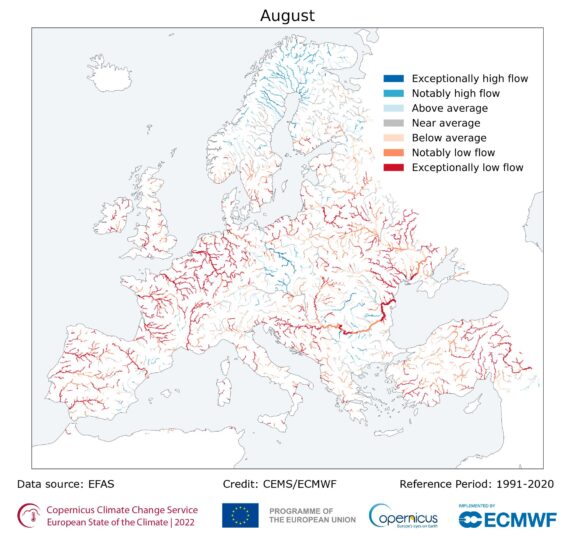The record heat and drought hurting European farmers, power utilities and insurers foreshadows even faster change to the continent’s climate, with scientists warning that feedback loops from a drying Earth likely will lead to dangerously high temperatures again this year.
The European Union’s newest climate assessment, published Thursday by its Copernicus Climate Change Service, shows how scientists and policy makers are preparing to adapt to life on a hotter planet. The bloc’s spending billions of euros on new Earth observation space missions focused on helping its 450 million-person economy hedge against decreasing arable land, shrinking water levels and more wildfires.
Scorching, arid weather means diminished harvests that exacerbate food insecurity, and river levels so low they snarl transport and force power plants to shut down. France already is imposing so-called sobriety measures, with the European Commission also considering more ways to preserve suddenly scarce water resources.
“We are really moving into unchartered territory, where our collective experience will be less useful than it was even a few decades ago,” said Carlo Buontempo, the director of Copernicus.

The Copernicus program uses billions of measurements from satellites, ships, aircraft and weather stations around the world for its monthly and seasonal forecasts. Along with the European Space Agency, Copernicus plays a central role in the EU’s €16 billion ($17.5 billion) effort to get ahead of climate change through accurate forecasting. It’s already the world’s biggest provider of climate data.
But while better predictions might help farmers choose to plant drought-resistant crop varieties, or engineers plan better irrigation, they don’t blunt the economic pain of climate change when it happens. Record-high summer temperatures — 1.4C (2.5F) above the historic average — decimated harvests across France and central Europe last year. Climate-related losses worldwide soared to an estimated $270 billion.
A dry spell currently is wilting crops and delaying plantings in some of Europe’s top produce growers, risking a further run-up in food inflation.
“We’ve already seen some reports of water stress in Mediterranean countries,” said Samantha Burgess, deputy director of Copernicus. “Unless we have significant spring rainfall, the probability that there will be below-average water availability is likely to continue.”
European rivers experienced a sixth-consecutive year of below-average flows in 2022, leading to the “driest year on record” in geographical reach, according to Copernicus. Low water levels snarled freight passage on river ways that contribute €80 billion to EU economies. Dry riverbeds forced hydropower and nuclear plants to curtail electricity generation, helping push power prices to record highs.
“We really need, at this moment in time, to look at how we can introduce adaptation policies,” said Mauro Facchini, who oversees Copernicus at the European Commission.
The signs are worrying, say European researchers using Copernicus data. A hotter and drier environment is dramatically reducing soil moisture, with severe impacts on future crop production in places like southern Europe, which could lose large swathes of arable land by 2050, according to a study that will be presented next week to the European Geosciences Union. Last year’s moisture total was the second-lowest in a half-century, Copernicus calculated.
“A few years ago, I would never have imagined that water would be a problem here in Europe, especially in Germany or Austria,” said Torsten Mayer-Guerr, an Austrian researcher studying the Earth’s water mass.
Data suggesting water scarcity could become the new normal have led scientists to redouble focus on how the resource cycles through the Earth. The trouble isn’t just less rain — dropping 10% last year by Copernicus estimates — but lost Alpine snow cover and rapidly shrinking glaciers. Taken together, the diminished trickle into Europe’s lakes and seas compounds environmental risks by raising water temperatures and harming ecosystems.
And then there’s the higher probability of wildfire, which torched European landscapes three times the size of Luxembourg last year.
“There is a feedback loop there,” Buontempo said. “The dry conditions may have, in return, contributed to the extreme high temperatures. A further consequence of the dry conditions was the spread and intensification of wildfires.”
Copernicus, the ESA and NASA are developing new missions to better understand Earth’s water cycle. One — codenamed MAGIC — plans to launch a pair of satellites 500 kilometers (311 miles) into orbit, where they’ll be able to measure small-scale variations to water storage.
“We know that near real-time availability of data is important for making decisions,” Burgess said, noting that the food, energy and insurance industries already are using Copernicus data.
Copernicus reported at least one silver lining to Europe’s struggle with global warming: 2022 yielded stronger solar radiation that led to above-average photovoltaic power generation. Installing more emissions-free energy sources remains the world’s best bet for keeping temperature rises below the 1.5C threshold this century.
Topics Europe
Was this article valuable?
Here are more articles you may enjoy.


 Former Congressman Charged After Collision with State Trooper in Florida
Former Congressman Charged After Collision with State Trooper in Florida  Investment Funds File New Suits Over Lighthouse Insurance Collapse in 2022
Investment Funds File New Suits Over Lighthouse Insurance Collapse in 2022  Why New York’s Attorney General Objects to Trump’s Bond Insurer
Why New York’s Attorney General Objects to Trump’s Bond Insurer  FBI Says Chinese Hackers Preparing to Attack US Infrastructure
FBI Says Chinese Hackers Preparing to Attack US Infrastructure 

